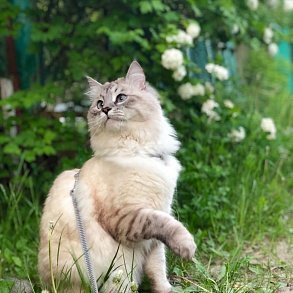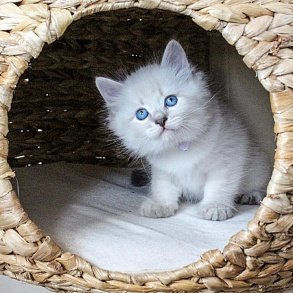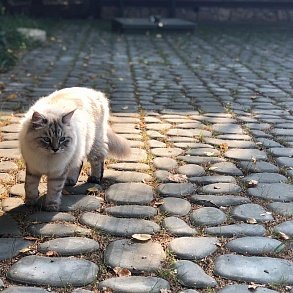Neva Masquerade Cat

Neva masquerade cat is a beautiful and noble animal, famous for its luxurious "fur coat". She is characterized by cheerfulness, intelligence, curiosity, very affectionate and friendly.
- Brief information
- Highlights
- Breed characteristics
- History of the Neva Masquerade cat breed
- Appearance of the Neva masquerade cat
- The character of the Neva masquerade cat
- Care and maintenance
- Health and diseases of the Neva masquerade cat
- How to choose a kitten
- How much does the Neva masquerade cat cost
Brief information
- Breed name: Neva masquerade cat
- Country of Origin: Russia
- Birth time of the breed: 1988
Highlights
- Neva masquerade cat combined in its appearance the typical features of Siberian cats and representatives of the feline genus with a color-point color.
- A variety of coat colors are allowed in the color of the animal, an unquestioning requirement is a color point pattern.
- Representatives of this breed are strong, massive, muscular, stand out for their impressive size. True, kitties are much smaller and more elegant than cats.
- Animals reach their full bloom by the age of five.
- Males are distinguished by independence, impressiveness and seriousness, females are softer and friendlier, but both do not like strangers, treat them with caution. They do not tolerate familiarity with themselves.
- Despite their large size, Neva masquerades are extremely agile, agile, and demonstrate excellent jumping ability.
- Possess excellent hunting qualities, being a thunderstorm of rodents and birds. They are friendly to other animals, but under certain circumstances they can stand up for themselves.
- Neva masquerade cats are devoted animals who adore their owners and need their love.
- Kotofei treat children's pranks with understanding, behave cautiously with the kids, even patronizingly.
- Pets require systematic care of their fur, especially during molting, which occurs twice a year. Sterilized animals shed less.
Neva masquerade cat captivates with her aristocratic beauty and good manners, and her devoted and tender attitude to the owners is incredibly touching. The character of this cute animal combines playfulness and restraint, sociability and the absence of any importunity, curiosity and delicacy, kindness and willingness to fight back in case of danger. The cat retains its mobility, curiosity, agility and incredible grace even in old age.
Breed characteristics
History of the Neva masquerade cat breed
Neva masquerade is a breed of cats that domestic breeders began breeding in the 80s of the last century. It is precisely known that the dominant role in the formation of the breed belongs to siberian cats . There are still disputes about which of the feline representatives is "responsible" for their color-point color. According to one version, the color went to the Neva masquerade from persian point cats , according to another version, the new breed is the result of an arbitrary crossing of heroes – Siberians with their siamese relatives.
The breeders from the Leningrad club "Kotofey" became the initiator of breeding a new breed. The work was conducted under the guidance of the famous felinologist, an expert of the international category Olga Mironova. In 1988, the Neva masquerade was presented at a cat show in Leningrad. It owes its name to the river on which the Northern Capital of Russia stands, and the delightful color of its muzzle, reminiscent of a playful masquerade mask. Today, this cat is often called nevak for short, another of its names is carnival.
Felinologists from Moscow continued the breeding of the Neva masquerade cat. They preferred to engage in breeding independently of their fellow innovators from the city on the Neva, which led to a greater variety of Nevak colors.
At the end of the 80s, Russian felinologists-enthusiasts began to bring Siberian cats to the international arena and gradually achieved that this breed was recognized by leading felinological organizations. The name "Neva masquerade" was registered as the standard of one of the original colors siberian breed of cats . In 1992, the WCF recognized the Neva Masquerade cat as an independent breed. Later, this status was granted to her by several other reputable felinological organizations, but most associations still recognize her only as a separate color of Siberians. However, this fact does not affect the popularity of these cute creatures among Russians, and breeders continue to work hard to improve the breed.
Video: Neva Masquerade cat
Appearance of the Neva masquerade cat
Nevsky Masquerade is a large and strong cat, whose elegant appearance is a delight. Nevaki cats have a very personable and self-confident appearance, which is not surprising, because their weight is sometimes 10 kg. Kitties, whose weight, as a rule, does not exceed 6 kg, look elegant and have pronounced noble manners.
Housing
The Neva masquerade cat is proportionally folded. Her torso is of medium length, not elongated. The backbone is strong, massive, the neck is powerful, short, the chest is voluminous, the muscles are well developed.
Head
The head is proportional to the body, massive, its shape is similar to a wedge, has smoothly rounded outlines. The broad, low forehead is rounded. The nose is wide, its length is average. With a smooth transition from the frontal part to the nose, a slight depression is noticeable in the profile, there is no stop. The cheekbones are low, the cheeks are plump, the jaws are sufficiently developed. The chin is wide, powerful, but not extended.
Ears
The ears of the Neva masquerade cat are medium in size, wide at the base, barely noticeably tilted forward, their tips are slightly rounded. The distance between them is slightly more than the width of one ear at the base. The outer line of the eyelet is almost vertical, its base from the outside is located just above eye level.
Eyes
The eyes of the Nevaks are almost round, set slightly obliquely, their color is blue, but up to a year it may have a greenish tinge. In animals of the red point color, against the background of bright red fur on the muzzle, the eye color seems to be rich blue.
Limbs
Limbs of Neva masquerade cats of medium length, strong. The paws are large, round, fur grows in tufts between the fingers.
Tail
The tail is of medium length, it is richly pubescent and resembles a fox. The tip of the tail is rounded.
Wool
The luxurious semi–long coat of the Neva masquerade cats, which they inherited from the Siberians, is shiny, water-repellent. It extends from the shoulder blades to the croup, falling on the sides and the base of the tail. The adorning wool forms a mane around the neck and elegant "pants". During the period of seasonal molting, little remains of the adorning wool. The undercoat of a cat in winter becomes long, thick, dense, and in summer – insignificant, shortish.
Color
The coat of the Neva masquerade on the body is painted in light tones, on the tips of the ears, paws, tail the fur is dark. The mask itself has a dark color on the cat's muzzle. Depending on the color of the dark fragments, the colors of the nevaks are divided into the main categories:
- seal point and seal tabby point (the most common);
- blue point;
- red point;
- turtle point (found only in females).
Not so long ago, many colors with silvery shades were bred. Today, all variations of colors are recognized, with the exception of those that belong to the chocolate-purple range.
The contrast between the dark areas and the main color of the coat should be pronounced noticeably. The dark fragments on each part of the nevak's body should have the same color intensity.
Disadvantages
- Excessive miniaturization and elegance: weak bones, small paws, fragile elongated neck, long and thin limbs.
- Narrow muzzle with a straight profile and undeveloped cheekbones.
- Too big or too small ears, as well as their excessive droop.
- Small, deep-set eyes.
- Shortish, sparsely pubescent tail, its sharpness.
- Lack of undercoat and shine of the coat, as well as too long undercoat.
The character of the Neva masquerade cat
The Neva masquerade cat is a noble creature. She is distinguished by a pronounced sense of self-esteem, which makes you think: is it worth getting familiar with her? If this aristocrat can afford some familiarity with her owners and babies, to whom she treats very carefully, then it is better for outsiders not to show increased interest in her, to take her in their arms, and, moreover, to provoke her.
In a homely atmosphere, nevaks behave calmly and equably, they are attached to all family members. These cats like to be paid attention to, but they never show obsession. They like to "talk", and they themselves know how to listen attentively and understandingly, they are always ready to calm worried or upset hosts by humming a song to them or gently cooing.
Neva masquerade cats are very active, they love outdoor games that simulate hunting. They are very curious: if the owners are doing housework, they will always come running to find out what's going on and demonstrate a desire to participate, to help. They will not ignore any new item in the house with their attention.
In nature, Neva masquerade cats, accustomed to living conditions in an apartment, adapt quickly, their willingness to stand up for themselves is expressed immediately, although they are not the first to show aggression towards other animals. Living in country houses, these cats easily find a "common language" with neighboring pets who show friendliness. However, their peacefulness does not extend to all animals: they are excellent hunters, they ruthlessly deal with mice, ambush moles, they do not spare innocent birds.
Care and maintenance
First of all, the Neva masquerade cat needs to take care of its luxurious fur, which is renewed almost all year round. Especially carefully take care of her "outfit" should be during the periods of seasonal molting: September-November and February-April (the intensity and duration of molting for each animal is different). To help the nevak get rid of the old wool as soon as possible, during these months it needs to be bathed once a week.
Bathing the Neva masquerade cat will require you to be diligent and thorough. For the effectiveness of the procedure, the cat needs to be soaped three times and "rinsed" the same number of times. This can be done in the bathroom and basin. The level of the collected water should be about 10 cm, the temperature is 38-40 ° C. It is better to put the cat on a rubber mat or towel, so it will be more comfortable. Wool should be washed from shampoo very scrupulously. After the last "rinse", fill a basin or bucket with warm water, squeeze the juice of one lemon into it and rinse the wool again. At the end of the procedure, the cat's "fur coat" should creak when fingering the villi with your fingers. After bathing, the animal needs to be thoroughly dried. You can use a hairdryer or buy baby diapers for this purpose at the pharmacy – they absorb moisture perfectly.
To bathe the Neva masquerade, use special shampoos for long-haired cats. Some of them differ in that after their application, the cat practically does not need combing. Another means for bathing an animal is baby soap.
The Neva masquerade cat should be accustomed to water procedures from childhood. The kitten can be bathed no more than once every two months. This is allowed only if the baby is completely healthy. You can not bathe the animal in a two-week period after vaccination. Kittens are bathed in a basin, the water in which you need to pour from the shower, so that the noise from falling water does not frighten them. During the procedure, the baby needs to be held by the front paws and comment on his every action in a gentle voice.
Nevaka needs to be combed at least twice a week. This is done with an ordinary metal comb with blunt teeth. The direction is from the head to the tail. The tail itself cannot be combed: the hairs on it are very weak and fall out easily, and new ones grow for a long time. The Neva masquerade cat perfectly copes with the care of its chic tail by itself.
Despite the fact that the wool of representatives of this breed practically does not fall off, in cases when the owner is lazy to take care of it, tangles may still form. If this happens, you need to take a small comb and carefully, slowly, thread the teeth between the skin and the tangle. Then carefully remove the tangle with nail scissors. Koltunorez in this case is not a suitable thing. And it is not recommended to cut the cat, since the growing hair will have a darker color.
The ears, eyes and teeth of the Neva masquerade cat also need systematic care. The ears should be cleaned once a month. It is convenient to do this with a stick with a cotton swab that needs to be dipped in petroleum jelly, olive oil or ordinary vegetable oil. Before the procedure, the tampon must be wrung out.
Wipe your eyes with a damp cotton wool soaked in warm water or strong tea. The main thing is to wipe the tear channels – "tracks" near the base of the nose.
Brush your teeth with a small toothbrush using a special toothpaste for animals.
Neva masquerade cats demonstrate excellent appetite, but are distinguished by aristocratic pickiness in food. To understand what exactly your beauty likes, buy her several types of ready-made premium food and watch which one she prefers.
Among natural products, beef, rabbit, chicken are useful for non-fishermen. It is possible to treat these cats in small quantities and not often with liver, sea fish. Low-fat cottage cheese, yogurt, kefir will be useful for pets from fermented milk products.
An adult cat should be fed 2 times a day. Feeding a kitten begins with five meals a day, as it grows up, the number of meals per day gradually decreases.
Health and diseases of the Neva masquerade cat
Neva masquerade cats are distinguished by strong immunity and excellent health. There are many centenarians among them, some of whom live up to 20 years.
Basically, the danger for this breed is such a dangerous hereditary disease as hypertrophic cardiomyopathy, in which the blood in the pulmonary vessels stagnates. In the early stages, this ailment does not manifest itself in any way, and it is possible to determine that the animal is unhealthy only when the Neva masquerade cat begins shortness of breath and chronic fatigue is observed. If it is still possible to detect the disease at the very beginning of its occurrence, the cat can be saved with the help of supportive therapy.
Another serious problem for the nevak can be created by his coat: the fallen hairs often fall together with food into the stomach. They are not digested, but form bezoars – fur balls that cause a disorder of the digestive system. The animal can get rid of them on its own, thanks to the vomiting reaction, but you can help the cat to cause vomiting. To do this, an adult cat needs to be given one tablespoon of vegetable oil (not castor oil!), one teaspoon will be enough for a kitten.
How to choose a kitten
Buy the Neva masquerade kitten after he turned 3 months old. Until this age, it is better for him to stay with his cat mom and siblings. If the seller offers you a baby who is not yet 2.5 months old, this should alert you.
Neva masquerade kittens are born snow-white, without any spots and markings. Already at a very early age, they look much larger than babies of other breeds.
To be sure of the purebred and healthy kitten-nevak, contact the kennel. Here he will be accompanied by a veterinary passport, metric or pedigree. The veterinary passport should indicate that the animal has been dewormed, that is, he was given an anthelmintic drug. The passport must also contain documentary evidence that the baby has been given all the necessary vaccinations at this age.
When visiting the kennel, make sure that the atmosphere there is calm, the kittens are not shy, they are not shy of you, they are not nervous because of extraneous sounds and your sudden movements. These observations will confirm that they do not grow in a cage, but in comfortable conditions.
Having chosen one of the kids, start a game with him, during which the peculiarities of his character may manifest themselves. Get to know your chosen one's mother better: consider the cat and observe her behavior, because character traits, both good and not so, are inherited.
How much does the Neva masquerade cat cost
There are nurseries where you can buy kittens of the Neva masquerade cat in most major cities of Russia. Most of them are located in Moscow and St. Petersburg. Kittens can also be bought from a private owner or in a cat club. Please note: the difference in the cost of purebred babies cannot be significant.
Prices vary depending on the region and the class of the animal within $120 - $300 – this is the cost of pet-class and breed-class kittens. The former, according to the breeder, are not of interest for breeding work, and the latter have good reproductive characteristics.
The cost of a show-class kitten, a standard breed with an exhibition perspective, can reach up to $350. No less is a baby of a rare color – tortoiseshell.
And one more nuance: kitties are often more expensive than cats.


